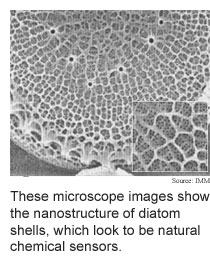
December
12, 2005
Nature's
nano sensors
When it comes to building nanostructures, nature has humanity
beat hands down. Millions of years of evolution will do that for you.
 Recently scientists have proposed using the nanostructured silica
shells of diatoms -- a type of algae -- to control lightwaves and as templates
for micro and nanodevices.
Recently scientists have proposed using the nanostructured silica
shells of diatoms -- a type of algae -- to control lightwaves and as templates
for micro and nanodevices.
Researchers from the Italian National Council of Research, 2nd
University of Naples and University of Naples "Federico II" have carried
out a detailed optical study
of marine diatoms and found that their shells' luminescence changes depending
on the type of gas surrounding them.
In the study, they fired laser beams at the shells of Thalassiosira
rotula in the presence of nitrous oxide, acetone, ethanol, air, xylene
and pyridine, and measured the wavelengths of the light emitted by the
shells in response. The shells turn slightly different colors depending
on the surrounding gas.
The ubiquity of diatoms and the variety of shell structures, which
vary by species, make them potentially useful for chemical sensing applications.
They could eventually be used, for example, in devices that monitor the
environment or detect chemical warfare agents.
(Marine Diatoms As Optical Chemical Sensors, Applied Physics
Letters, December 5, 2005)
Buckyballs bind to DNA
Scientists examining the interactions among nanoscale objects,
living beings and the environment are uncovering nanotechnology's dark
side.
Researchers from Oak Ridge National Laboratory and Vanderbilt
University have used computer
simulations to show that C60 molecules, or buckyballs, will attach
to and deform DNA molecules in aqueous environments.
Buckyballs, which are spheres of 60 carbon atoms, have been touted
as potential drug delivery vehicles. Given that the human body is an aqueous
environment, the simulations show that it might not be such a good idea
to flood the body with the molecules.
The study shows that buckyballs could have a negative impact on
the structure and biological functions of DNA molecules. The carbon molecules
bind to single- and double-stranded DNA, and bind to damaged sections
of DNA molecules, which could interfere with DNA's natural self-repair
process.
(C60 Binds to and Deforms Nucleotides, Biophysical Journal,
December 2005)
Quantum nets advance
Scientists have taken a significant step down the road to building
quantum networks, a technology that promises to extend quantum cryptography
systems over long distances and eventually link quantum computers.
Quantum cryptography systems promise potentially perfect security.
Quantum computers are theoretically many orders of magnitude faster than
today's classical computers for certain types of very large problems.
Separate research teams from Georgia Institute of Technology and
Harvard University have demonstrated (1,
2)
the ability to generate a photon from one cloud of atoms, transmit it
over optical fiber to another cloud of atoms, briefly store the photon
there, and then release it.
The next steps in this line of research are adding a third cloud
of atoms to demonstrate the necessary control of storage and retrieval
from the second cloud; transmitting, storing and retrieving quantum bits,
or qubits, rather than "blank" photons; increasing storage times and improving
the quality of the quantum information transmitted by the prototype network.
When perfected, the systems the researchers are developing could
be used as quantum repeaters -- the devices needed to boost fading signals
in quantum communications networks.
(Storage and Retrieval of Single Photons Transmitted between Remote
Quantum Memories, Electromagnetically Induced Transparency with Tunable
Single-Photon Pulses, Nature, December 8, 2005)
Shocks produce laser-like light
It looks like blasting crystals with shock waves makes them shine.
A theoretical study
by researchers from Lawrence Livermore National Laboratory and the Massachusetts
Institute of Technology predicts a new type of coherent light similar
to the light produced by lasers.
Shock waves through a crystalline material should produce coherent
electromagnetic radiation in the terahertz frequency range. Terahertz
waves fall between microwaves and infrared radiation in the electromagnetic
spectrum.
The speed of the shock waves and the distance between the atoms
or molecules in the crystal determine the exact frequency of the emitted
light. The technique could be used as a way of identifying the structure
of crystal materials, which helps determine their optical, mechanical
and electronic properties.
(Coherent Optical Photons from Shock Waves in Crystals, Physical
Review Letters, accepted for publication)
Bits and pieces
A chip
traps individual ions (as opposed to neutral atoms -- see Chip
protects single atoms, TRN, June 30/July 7, 2004), which opens a promising
route to quantum computers; a geometric
approach promises to improve data mining -- the practice of extracting
information from large amounts of computer data; "smart fluid" valves
speed biochips.
RSS Feeds: News Blog Books New: TRN's Internet Services TRN's Jobs Center News: Research News Roundup Research Watch blog Features: View from the High Ground Q&A How It Works Buy an ad link |
|
| Advertisements: |
|
Ad links: Clear History
Buy an ad link
|
TRN
Newswire and Headline Feeds for Web sites
|